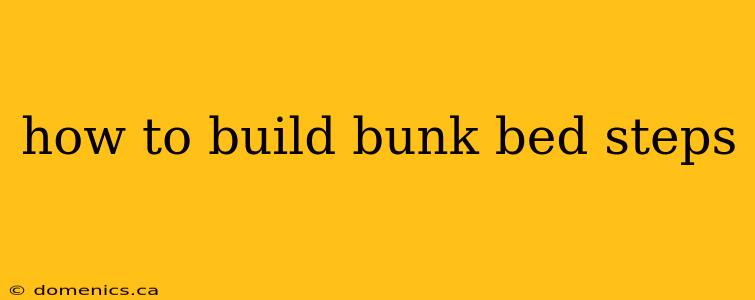Building bunk bed steps is a fantastic DIY project that enhances safety and style. This comprehensive guide will walk you through the process, from planning to completion. Whether you're a seasoned DIYer or a beginner, you'll find this a valuable resource for crafting sturdy and attractive steps for your bunk beds.
Planning Your Bunk Bed Steps
Before you start hammering, careful planning is crucial. This phase determines the success of your project.
1. Measure Your Bunk Bed:
Accurately measure the height and width of your bunk bed's lower frame. This determines the dimensions of your steps. Consider the distance between the floor and the bunk bed, accounting for any existing platforms or frames.
2. Choose Your Materials:
- Wood: Common choices include pine, oak, or other hardwoods. Pine is affordable and easy to work with. Hardwoods offer greater durability.
- Fasteners: Use strong screws appropriate for the wood type. Consider wood glue for added strength and stability.
- Stain/Paint: Protect and personalize your steps with your choice of stain or paint. Select a child-safe option if needed.
3. Design Your Steps:
Sketch your design. Consider the number of steps, their width, depth, and overall height. A good rule of thumb is to have steps at least 10-12 inches wide and 10-12 inches deep for optimal safety and comfort. Aim for a rise (vertical height) of 6-8 inches per step, ensuring even spacing.
Building Your Bunk Bed Steps: A Step-by-Step Guide
Now for the exciting part – constructing your steps!
1. Cut the Wood:
Using your measurements and design, cut the wood for the treads (horizontal steps) and risers (vertical supports). Ensure accurate cuts for a professional finish. Using a miter saw for precise angles is highly recommended.
2. Assemble the Risers:
Attach the risers to the side supports using wood glue and screws. Ensure the risers are perfectly vertical and evenly spaced. Clamp them together to ensure a tight fit while the glue dries.
3. Attach the Treads:
Carefully attach the treads to the risers, ensuring they are level and firmly secured. Use wood glue and screws for optimal strength. Make sure the treads extend slightly beyond the risers to make them easier to step on and offer a more finished look.
4. Sand and Finish:
Once the glue is dry, sand all surfaces smooth. This removes any rough edges and prepares the steps for staining or painting. Follow the manufacturer's instructions for your chosen finish. Two coats are usually recommended for optimal protection.
5. Attach to the Bunk Bed:
Carefully attach the completed steps to the bunk bed frame using appropriate fasteners. Ensure that the steps are securely fastened and sturdy. Use brackets or screws that are appropriate for both the material of your steps and your bunk bed frame.
Safety Considerations for Bunk Bed Steps
Safety should always be your top priority when building bunk beds and their accessories.
- Secure Fasteners: Use strong screws and wood glue to ensure the steps are securely attached.
- Appropriate Height and Depth: Adhere to the recommended rise and run for comfortable and safe steps.
- Smooth Edges: Sand all edges thoroughly to prevent splinters and injuries.
- Non-Slip Surface: Consider adding a non-slip surface to the treads for extra safety, especially in areas that are prone to moisture or spills. You can use strips of non-slip tape or apply a non-slip sealant.
- Regular Inspection: Periodically inspect the steps for any signs of damage or looseness. Replace or repair any damaged parts immediately.
Frequently Asked Questions (FAQs)
Q: What type of wood is best for bunk bed steps?
A: Pine is a popular choice due to its affordability and ease of use. Hardwoods like oak offer greater durability but are more expensive.
Q: How do I ensure the steps are securely attached to the bunk bed?
A: Use strong screws and, if possible, brackets designed to connect to the frame of your bunk bed.
Q: How can I make the steps more visually appealing?
A: Choose a stain or paint that complements your bedroom's decor. You can also add decorative elements, like molding or trim.
Q: What if my bunk bed is unusually high or low?
A: Adjust the number of steps and the rise/run accordingly to maintain safe and comfortable use. You may need to consult a professional if you have highly unusual dimensions.
By following these steps and prioritizing safety, you can build sturdy and attractive bunk bed steps that enhance your child's bedroom and provide a safe means of accessing the top bunk. Remember to always supervise children while using bunk beds and their steps.
